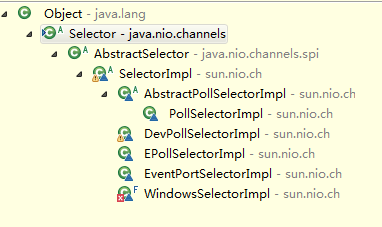1系列内容
- jdk Selector设计情况
- jdk nio poll在linux平台下的实现
- jdk nio epoll在linux平台下的实现
- netty 原生epoll在linux平台下的实现
- epoll的2种通知模式边缘触发、水平触发
2 jdk Selector概述
首先来看下文档描述
2.1 创建方式
一个就是直接调用open方法
public static Selector open() throws IOException {
return SelectorProvider.provider().openSelector();
}
或者调用选用某个SelectorProvider的openSelector
public abstract AbstractSelector openSelector()
2.2 SelectionKey
一个Selector有3种SelectionKey集合
-
一种就是全部注册的SelectionKey集合,即keys()方法返回的结果
-
一种就是活跃的SelectionKey集合,即selectedKeys()方法返回的结果
-
第三种就是已取消的SelectionKey集合,这些已被取消但是还未从Selector取消注册
再确认下下面的几个问题:
-
什么叫注册
即将一个channel感兴趣的事件注册到Selector上,即如下方法
SelectionKey register(AbstractSelectableChannel ch, int ops, Object att)对于select、poll的Selector实现:仅仅是保存上述AbstractSelectableChannel感兴趣的ops到指定地方
对于epoll的Selector实现:则是执行系统调用epoll_ctl方法,操作参数是EPOLL_CTL_ADD
-
什么叫取消
就是调用SelectionKey的cancel方法,该方法的实现是,将该SelectionKey放入cancelledKeys而已,没有做其他操作
-
什么叫取消注册
取消注册,就是从Selector从释放出来不再关注某个事件。通常在我们的select过程中就会遍历上述cancelledKeys,依次执行取消注册的行为。不同的Selector有不同的行为,如epoll则是执行系统调用epoll_ctl方法,操作参数是EPOLL_CTL_DEL。
2.3 三种select方式
分别如下:
int select():表示一直阻塞到有事件为止
int select(long timeout):最多阻塞timeout时间
int selectNow():不阻塞,检查结果后立即返回
2.4 并发性
Selector不是线程安全的,不过大部分情况都是一个线程拥有一个Selector,所以不需要它线程安全。
2.5 使用案例
以ZooKeeper为例,代码简述如下
final Selector selector = Selector.open();
public void run() {
while (!ss.socket().isClosed()) {
try {
selector.select(1000);
Set<SelectionKey> selected = selector.selectedKeys();
for (SelectionKey k : selected) {
if ((k.readyOps() & SelectionKey.OP_ACCEPT) != 0) {
//执行accept连接的事件
SocketChannel sc = ((ServerSocketChannel) k
.channel()).accept();
sc.configureBlocking(false);
SelectionKey sk = sc.register(selector,
SelectionKey.OP_READ);
NIOServerCnxn cnxn = createConnection(sc, sk);
sk.attach(cnxn);
addCnxn(cnxn);
} else if ((k.readyOps() & (SelectionKey.OP_READ | SelectionKey.OP_WRITE)) != 0) {
//执行IO读写事件
NIOServerCnxn c = (NIOServerCnxn) k.attachment();
c.doIO(k);
} else {
//未知
}
}
selected.clear();
} catch (RuntimeException e) {
LOG.warn("Ignoring unexpected runtime exception", e);
} catch (Exception e) {
LOG.warn("Ignoring exception", e);
}
}
closeAll();
LOG.info("NIOServerCnxn factory exited run method");
}
while循环里面不断调用selector.select(1000)方法,然后通过selector.selectedKeys()来获取到有事件的SelectionKey集合,即上述提到的活跃的SelectionKey集合。然后遍历该集合,执行对应的事件。
3 不同实现类
目前Selector目前有如下实现

针对linux平台的实现:
- PollSelectorImpl:基于poll来实现
- EPollSelectorImpl:基于epoll来实现
针对windows平台的实现:
- WindowsSelectorImpl
而Netty的NioEventLoop则是使用上述linux平台的实现PollSelectorImpl。Netty自己提供了另外一种epoll实现,没有直接采用上述jdk自带的EPollSelectorImpl。
4 后续
接下来就要开始重点说说jdk的poll是怎么实现的,即PollSelectorImpl的内容
来源:oschina
链接:https://my.oschina.net/u/2287728/blog/733626